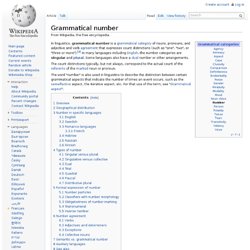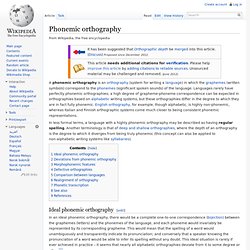Zoom
Trash
Related: Book material
- Dizionari & Glossari
- The problems with philosophy
- Education
- Enterprise

PARTS OF SPEECH. Grammatical number. In linguistics, grammatical number is a grammatical category of nouns, pronouns, and adjective and verb agreement that expresses count distinctions (such as "one", "two", or "three or more"). [ 1 ] In many languages including English , the number categories are singular and plural .

Some languages also have a dual number or other arrangements. The count distinctions typically, but not always, correspond to the actual count of the referents of the marked noun or pronoun. The word "number" is also used in linguistics to describe the distinction between certain grammatical aspects that indicate the number of times an event occurs, such as the semelfactive aspect, the iterative aspect, etc.
For that use of the term, see " Grammatical aspect ". Overview [ edit ] Most languages of the world have formal means to express differences of number. Grammatical number is a morphological category characterized by the expression of quantity through inflection or agreement. English [ edit ] Swedish [ edit ] Orthography. Most significant languages in the modern era are written down, and for most such languages a standard orthography has developed, often based on a standard variety of the language, and thus exhibiting less dialect variation than the spoken language.
Sometimes there may be variation in a language's orthography, as between American and British spelling in the case of English. If a language uses multiple writing systems, it may have distinct orthographies, as is the case with Kurdish, Uyghur, Serbian, Inuktitut and Turkish. In some cases orthography is regulated by bodies such as language academies, although for many languages (including English) there are no such authorities, and orthography develops through less formal processes.
Orthography is distinct from typography, which is concerned with principles of typesetting. Etymology and meaning[edit] The English word orthography dates from the 15th century. Units and notation[edit] Types[edit] Correspondence with pronunciation[edit] Phonemic orthography. A phonemic orthography is an orthography (system for writing a language) in which the graphemes (written symbols) correspond to the phonemes (significant spoken sounds) of the language.

Languages rarely have perfectly phonemic orthographies; a high degree of grapheme-phoneme correspondence can be expected in orthographies based on alphabetic writing systems, but these orthographies differ in the degree to which they are in fact fully phonemic. English orthography, for example, though alphabetic, is highly non-phonemic, whereas Italian and Finnish orthographic systems come much closer to being consistent phonemic representations.
In less formal terms, a language with a highly phonemic orthography may be described as having regular spelling. Another terminology is that of deep and shallow orthographies, where the depth of an orthography is the degree to which it diverges from being truly phonemic (this concept can also be applied to non-alphabetic writing systems like syllabaries). Pronunciation respelling for English. Pronunciation respelling is a notation used to convey the pronunciation of words, in a language, such as English, which does not have a phonemic orthography.

There are two basic types of pronunciation respelling. "Phonemic" systems, as commonly found in American dictionaries, consistently use one symbol per English phoneme. These systems are conceptually equivalent to the International Phonetic Alphabet (IPA) commonly used in bilingual dictionaries and scholarly writings, but tend to use symbols based on English rather than Romance-language spelling conventions (e.g. ē for IPA /i/) and avoid non-alphabetic symbols (e.g. sh for IPA /ʃ/). On the other hand, "non-phonemic"[1] or "newspaper"[2] systems, commonly used in newspapers and other non-technical writings, avoid diacritics and literally "respell" words making use of well-known English words and spelling conventions, even though the resulting system may not have a one-to-one mapping between symbols and sounds.
Notes[edit]